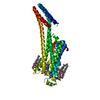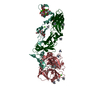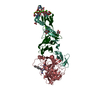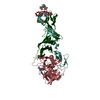+ Open data
Open data
- Basic information
Basic information
| Entry | Database: PDB / ID: 6sk0 | |||||||||
|---|---|---|---|---|---|---|---|---|---|---|
| Title | The VgrG spike from the Type 6 secretion system | |||||||||
 Components Components | Putative type VI secretion protein Type VI secretion system Type VI secretion system | |||||||||
 Keywords Keywords |  CHAPERONE / Puncture / spike / tip / carrier / CHAPERONE / Puncture / spike / tip / carrier /  inhibitor inhibitor | |||||||||
| Function / homology |  Function and homology information Function and homology information Type VI secretion system spike protein VgrG2, C-terminal domain of unknown function DUF2345 / Type VI secretion system spike protein VgrG2, C-terminal domain of unknown function DUF2345 /  Putative type VI secretion system, Rhs element associated Vgr domain / Uncharacterized protein conserved in bacteria (DUF2345) / Putative type VI secretion system, Rhs element associated Vgr domain / Uncharacterized protein conserved in bacteria (DUF2345) /  Putative type VI secretion system Rhs element Vgr / Putative type VI secretion system Rhs element Vgr /  Type VI secretion system, RhsGE-associated Vgr family subset / Phage tail baseplate hub (GPD) / Type VI secretion system, RhsGE-associated Vgr family subset / Phage tail baseplate hub (GPD) /  Type VI secretion system, RhsGE-associated Vgr protein / Type VI secretion system, RhsGE-associated Vgr protein /  Gp5/Type VI secretion system Vgr protein, OB-fold domain / Gp5/Type VI secretion system Vgr protein, OB-fold domain /  Type VI secretion system/phage-baseplate injector OB domain / Vgr protein, OB-fold domain superfamily Type VI secretion system/phage-baseplate injector OB domain / Vgr protein, OB-fold domain superfamilySimilarity search - Domain/homology | |||||||||
| Biological species |   Escherichia coli (E. coli) Escherichia coli (E. coli) | |||||||||
| Method |  ELECTRON MICROSCOPY / ELECTRON MICROSCOPY /  single particle reconstruction / single particle reconstruction /  cryo EM / Resolution: 2.3 Å cryo EM / Resolution: 2.3 Å | |||||||||
 Authors Authors | Rapisarda, C. / Fronzes, R. | |||||||||
| Funding support |  France, France,  Germany, 2items Germany, 2items
| |||||||||
 Citation Citation |  Journal: EMBO J / Year: 2020 Journal: EMBO J / Year: 2020Title: Structural basis for loading and inhibition of a bacterial T6SS phospholipase effector by the VgrG spike. Authors: Nicolas Flaugnatti / Chiara Rapisarda / Martial Rey / Solène G Beauvois / Viet Anh Nguyen / Stéphane Canaan / Eric Durand / Julia Chamot-Rooke / Eric Cascales / Rémi Fronzes / Laure Journet /  Abstract: The bacterial type VI secretion system (T6SS) is a macromolecular machine that injects effectors into prokaryotic and eukaryotic cells. The mode of action of the T6SS is similar to contractile phages: ...The bacterial type VI secretion system (T6SS) is a macromolecular machine that injects effectors into prokaryotic and eukaryotic cells. The mode of action of the T6SS is similar to contractile phages: the contraction of a sheath structure pushes a tube topped by a spike into target cells. Effectors are loaded onto the spike or confined into the tube. In enteroaggregative Escherichia coli, the Tle1 phospholipase binds the C-terminal extension of the VgrG trimeric spike. Here, we purify the VgrG-Tle1 complex and show that a VgrG trimer binds three Tle1 monomers and inhibits their activity. Using covalent cross-linking coupled to high-resolution mass spectrometry, we provide information on the sites of contact and further identify the requirement for a Tle1 N-terminal secretion sequence in complex formation. Finally, we report the 2.6-Å-resolution cryo-electron microscopy tri-dimensional structure of the (VgrG) -(Tle1) complex revealing how the effector binds its cargo, and how VgrG inhibits Tle1 phospholipase activity. The inhibition of Tle1 phospholipase activity once bound to VgrG suggests that Tle1 dissociation from VgrG is required upon delivery. | |||||||||
| History |
|
- Structure visualization
Structure visualization
| Movie |
 Movie viewer Movie viewer |
|---|---|
| Structure viewer | Molecule:  Molmil Molmil Jmol/JSmol Jmol/JSmol |
- Downloads & links
Downloads & links
- Download
Download
| PDBx/mmCIF format |  6sk0.cif.gz 6sk0.cif.gz | 162.5 KB | Display |  PDBx/mmCIF format PDBx/mmCIF format |
|---|---|---|---|---|
| PDB format |  pdb6sk0.ent.gz pdb6sk0.ent.gz | 119.4 KB | Display |  PDB format PDB format |
| PDBx/mmJSON format |  6sk0.json.gz 6sk0.json.gz | Tree view |  PDBx/mmJSON format PDBx/mmJSON format | |
| Others |  Other downloads Other downloads |
-Validation report
| Arichive directory |  https://data.pdbj.org/pub/pdb/validation_reports/sk/6sk0 https://data.pdbj.org/pub/pdb/validation_reports/sk/6sk0 ftp://data.pdbj.org/pub/pdb/validation_reports/sk/6sk0 ftp://data.pdbj.org/pub/pdb/validation_reports/sk/6sk0 | HTTPS FTP |
|---|
-Related structure data
| Related structure data |  10219MC  6sjlC  6skiC M: map data used to model this data C: citing same article ( |
|---|---|
| Similar structure data |
- Links
Links
- Assembly
Assembly
| Deposited unit | 
|
|---|---|
| 1 |
|
- Components
Components
| #1: Protein |  Type VI secretion system / Type VI secretion system tip protein VgrG Type VI secretion system / Type VI secretion system tip protein VgrGMass: 92657.219 Da / Num. of mol.: 3 Source method: isolated from a genetically manipulated source Source: (gene. exp.)   Escherichia coli (E. coli) Escherichia coli (E. coli)Gene: vgrG, DL654_23170, DM280_18435, EF082_25505, EHD42_22735, EIT12_22235, EIT27_22025, NCTC9044_02519 Production host:   Escherichia coli (E. coli) / References: UniProt: A0A3W2RZ19 Escherichia coli (E. coli) / References: UniProt: A0A3W2RZ19 |
|---|
-Experimental details
-Experiment
| Experiment | Method:  ELECTRON MICROSCOPY ELECTRON MICROSCOPY |
|---|---|
| EM experiment | Aggregation state: PARTICLE / 3D reconstruction method:  single particle reconstruction single particle reconstruction |
- Sample preparation
Sample preparation
| Component | Name: Tle1 effector bound to the VgrG spike of the type 6 secretion system Type: COMPLEX / Entity ID: all / Source: RECOMBINANT |
|---|---|
| Molecular weight | Value: 0.956 MDa / Experimental value: NO |
| Source (natural) | Organism:   Escherichia coli (E. coli) Escherichia coli (E. coli) |
| Source (recombinant) | Organism:   Escherichia coli (E. coli) Escherichia coli (E. coli) |
| Buffer solution | pH: 7.5 |
| Specimen | Conc.: 0.6 mg/ml / Embedding applied: NO / Shadowing applied: NO / Staining applied : NO / Vitrification applied : NO / Vitrification applied : YES : YES |
Vitrification | Instrument: FEI VITROBOT MARK IV / Cryogen name: ETHANE / Humidity: 100 % / Chamber temperature: 277 K |
- Electron microscopy imaging
Electron microscopy imaging
| Experimental equipment |  Model: Titan Krios / Image courtesy: FEI Company |
|---|---|
| Microscopy | Model: FEI TITAN KRIOS |
| Electron gun | Electron source : :  FIELD EMISSION GUN / Accelerating voltage: 300 kV / Illumination mode: FLOOD BEAM FIELD EMISSION GUN / Accelerating voltage: 300 kV / Illumination mode: FLOOD BEAM |
| Electron lens | Mode: BRIGHT FIELD Bright-field microscopy Bright-field microscopy |
| Image recording | Electron dose: 1.28 e/Å2 / Film or detector model: GATAN K2 SUMMIT (4k x 4k) |
- Processing
Processing
| EM software |
| ||||||||||||||||||||||||
|---|---|---|---|---|---|---|---|---|---|---|---|---|---|---|---|---|---|---|---|---|---|---|---|---|---|
CTF correction | Type: PHASE FLIPPING AND AMPLITUDE CORRECTION | ||||||||||||||||||||||||
| Symmetry | Point symmetry : C1 (asymmetric) : C1 (asymmetric) | ||||||||||||||||||||||||
3D reconstruction | Resolution: 2.3 Å / Resolution method: FSC 0.143 CUT-OFF / Num. of particles: 468438 / Symmetry type: POINT | ||||||||||||||||||||||||
| Atomic model building | Protocol: BACKBONE TRACE |
 Movie
Movie Controller
Controller















 PDBj
PDBj
